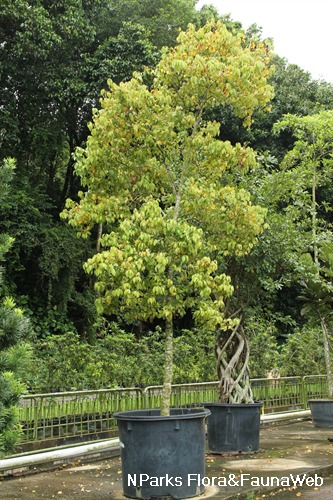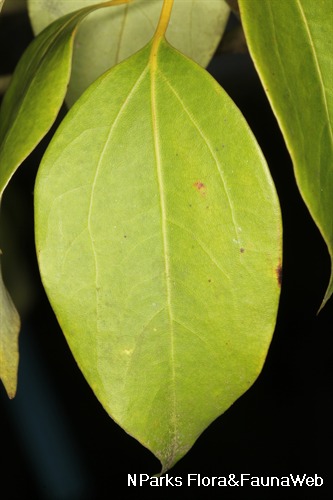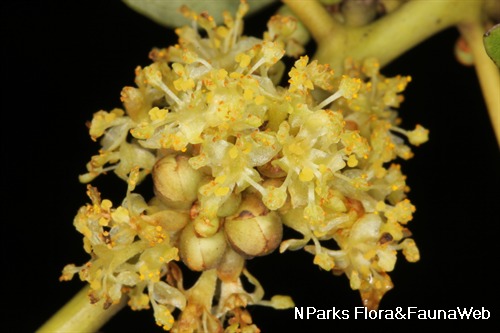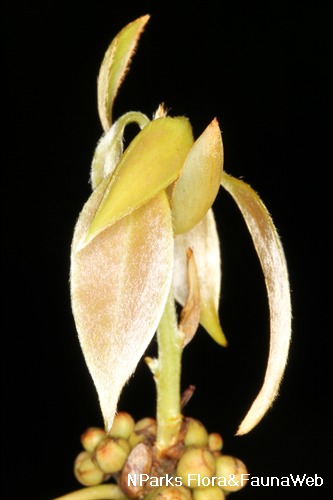
Back
Neolitsea cassia (L.) Kosterm.
| Family Name: | Lauraceae |
| Synonyms: | Neolitsea zeylanica (Nees) Merr, Neolitsea latifolia (Blume) S.Moore |
| Common Name: | Shore Laurel, Tejur, Tejur Pasir, Medang Pasir, 南亚新木姜子 |
Name
Classifications and Characteristics
| Plant Division | Angiosperms (Flowering Seed Plants) (Dicotyledon) |
|---|---|
| Plant Growth Form | Tree (Medium (16m-30m), Small (6m-15m)) |
| Lifespan (in Singapore) | Perennial |
| Mode of Nutrition | Autotrophic |
| Plant Shape | Irregular |
| Maximum Height | 20 m |
Biogeography
| Native Distribution | From India, Sri Lanka to south China, Southeast Asia (including Singapore) to Australia. |
|---|---|
| Native Habitat | Terrestrial (Primary Rainforest, Coastal Forest) |
| Preferred Climate Zone | Tropical |
| Local Conservation Status | Native to Singapore (Least Concern (LC)) |
Description and Ethnobotany
| Growth Form | It is a tree, up to 20 m tall. |
|---|---|
| Foliage | Its stalked, alternate leaves are oval to oblong in shape, 7-11 by 2.4-4 cm, with three distinct nerves from the base. Young leaves are pubescent. |
| Crown Shaft | Its tiny flowers develop in greenish flower-heads . |
| Flowers | Its tiny flowers develop in greenish, almost stalkless flower-heads that are 9 mm-wide at the leaf axils. |
| Fruit | Its round fruits are 6-7 mm wide, turning reddish then black when ripe. |
| Habitat | It grows most commonly along the coast,and sometimes in inland forest, and limestone areasup to 1,000 m altitude. |
| Associated Fauna | Its flowers are probably pollinated by insects. The fruits are eaten by birds. It is the host-plant of the Common Bluebottle (Graphium sarpedon luctatius). |
| Cultivation | It can be propagated by seed. |
| Etymology | Greek neos, new; Litsea, from the Mandarin characters li; plum, and tse, little, referring to the plant’s Chinese name; Latin zeylanica, from Sri Lanka (Ceylon), referring to one of the countries within the species' distribution range. |
| Ethnobotanical Uses | Medicinal: The root isused for poulticing skin rash on fingers. Timber & Products: The timber of this species is a constituent ofthe commercial timber called medang. It is utilised for building houses, planks, and rafters. |
Landscaping Features
| Landscaping | It has a dense conical shaped crown, and leaves that are golden coppery in colour when young. It is a shrub or tree suitable for gardens, parks and roadsides. |
|---|---|
| Desirable Plant Features | Ornamental Foliage, Ornamental Form |
| Landscape Uses | General, Suitable for Roadsides, Parks & Gardens, Small Gardens, Coastal |
Fauna, Pollination and Dispersal
| Fauna Pollination Dispersal Associated Fauna | Bird-Attracting, Butterfly Host Plant |
|---|---|
| Pollination Method(s) | Biotic (Fauna) |
| Seed or Spore Dispersal | Biotic (Fauna) |
Plant Care and Propagation
| Light Preference | Full Sun |
|---|---|
| Water Preference | Moderate Water |
| Plant Growth Rate | Moderate |
| Rootzone Tolerance | Moist Soils, Well-Drained Soils |
| Propagation Method | Seed |
Foliar
| Foliage Retention | Evergreen |
|---|---|
| Mature Foliage Colour(s) | Green |
| Mature Foliage Texture(s) | Leathery |
| Foliar Type | Simple / Unifoliate |
| Foliar Arrangement Along Stem | Alternate, Spiral |
| Foliar Attachment to Stem | Petiolate |
| Foliar Shape(s) | Non-Palm Foliage (Ovate, Oblong) |
| Foliar Venation | Pinnate / Net |
| Foliar Margin | Entire |
Floral (Angiosperm)
| Flower Colour(s) | Green - Light Green |
|---|---|
| Flower Grouping | Cluster / Inflorescence |
| Flower Location | Axillary |
Fruit, Seed and Spore
| Mature Fruit Colour(s) | Black, Red |
|---|---|
| Fruit Classification | Simple Fruit |
| Fruit Type | Fleshy Fruit , Non-Accessory Fruit |
References
| References | Ng, F.S.P. 2005. Taxonomic Notes on Bornean Litsea, Lindera, Neolitsea and Iteadaphne (Lauraceae). Gardens Bulletin Singapore . 57. 217 – 246 |
|---|
Image Repository
Others
| Master ID | 1969 |
|---|---|
| Species ID | 3261 |
| Flora Disclaimer | The information in this website has been compiled from reliable sources, such as reference works on medicinal plants. It is not a substitute for medical advice or treatment and NParks does not purport to provide any medical advice. Readers should always consult his/her physician before using or consuming a plant for medicinal purposes. |



